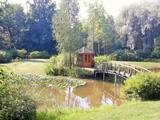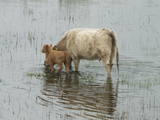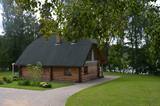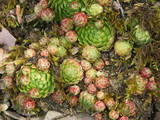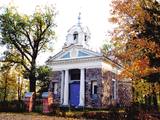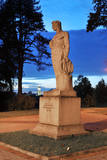| Nr | Nosaukums | Apraksts |
|---|---|---|
|
Mūsdienās redzamais iespaidīgais dievnams tapis ilgākā laika posmā. Jau 1870. g. latviešu draudze sāka vākt ziedojumus neogotiskās baznīcas celtniecībai, ko pabeidza 1904. gadā (V. Neimaņa projekts). Ēkas iekšpusi rotā dekoratīvi zvaigžņu velvju griesti, bet tās altārdaļā izvietotasmākslinieka J. Šķērstena veidotās vitrāžas (1940. g.) un 17. gs. kristāmtrauks. Baznīcu ieskauj plašs dārzs. |
||
|
Pastariņa muzejs ir izveidots tipiskā Ziemeļkurzemes lauku sētā Tukuma novadā. Muzejs veltīts rakstniekam Ernestam Birzniekam - Upītim, kurš bērnībā saukts par Pastariņu. "Bisnieku" viensēta, kurā rakstnieks dzimis, ir vairāk kā 400 gadus sena, un vēsturiskās ēkas tajā atjaunotas atbilstoši 20. gadsimta vidus situācijai, kad sētā saimniekoja rakstnieka brālis Kārlis Birznieks. Atjaunotajās ēkās - klētī, seklā kūtī, pirts-dārē, dziļajā kūtī un vāgūzī - izveidotas ekspozīcijas, kuras caurvij rakstnieka stāstu motīvi. Apmeklētājiem tiek piedāvātas dažādas izglītojošas programmas. Iespējams izzināt arī 19. gadsimta beigu maizes cepšanas tradīcijas un pašiem izcept maizes kukulīšus. Cepot maizi, var uzzināt vairāk par rakstnieka dzīvi un bērnības dienām "Bisniekos", kā arī daiļradi. Muzejā tradicionāli tiek svinēti saulgrieži, notiek arī krustabas un aktivitātes jaunlaulātajiem. |
||
|
Brenguļu alus darītava atrodas bijušā Abula hidroelektrostacijas ēkā. Alu ražo no vietējo zemnieku izaudzētajiem graudiem, un alus (nefiltrēts, nepastarizēts) darināšanā izmanto senču zināšanas. Ceļa otrā pusē uzpludinātā Abula krastā izveidots alus dārzs, kurā var baudīt un iegādāties tumšo un gaišo Brenguļu alu, kā arī nobaudīt latviskus ēdienus. |
||
|
Mūsdienās redzamo (pēc skaita – trešo) baznīcu cēla laikā no 1835. - 1837. g. (ampīra stilā) Mārča Sāruma vadībā. Arī šīs ēkas projektēšanā par paraugu bija ņemts Pievolgas vācu baznīcu veidols, tādēļ tā līdzīga Dzērbenes luterāņu baznīcai. Dievnama altāri rotā Otto Donnera fon Rihtera glezna “Kristus debesbraukšana” (1898. g.). E. Martina firmā būvētās 10 reģistru ērģeles (1901. g.) darbojās arī šodien. Pie Drustu baznīcas atrodas 1932. g. atklātais un formās iespaidīgais (E. Kuraua firmas veidots) granīta piemineklis 1. pasaules karā un Latvijas Brīvības cīņās kritušo piemiņai. Nelielā baznīcas sienas nišā novietota piemiņas plāksne komunisma terora upuriem. |
||
|
Ēku, kas uzbūvēta (1808. – 1810. g.) Doma kalna DA daļā, dēvē par Igaunijas zinātnes pērli. Observatorijā iekārtots atraktīvs muzejs. |
||
|
Atrodas Rīgas – Daugavpils autoceļa (A 6) 118. kilometrā. |
||
|
Tas ir viens no pirmajiem Lietuvas botāniskajiem parkiem. 1928.gadā I.Navidanskas, kuram tolaik bija vien 16 gadu, uzsāka parka veidošanu. 1965.gadā parku nodēvēja par Žemaitijas botānisko parku. Izidors kopā ar dēlu Rapolu, kurš šobrīd ir parka īpašnieks, turpināja paplašināt parku. |
||
|
Seklais un aizaugošais (ap 65 %) Engures ezers ir ne tikai viens no bagātākajiem Latvijas putnu ezeriem (Ramsāres konvencijas vieta, konstatētas 186 ligzdojošo putnu sugas), bet tā apkārtne izceļas arī ar lielu botānisko daudzveidību (> 800 augu sugas). Atšķirīgais jūras krasts (smilšaini liedagi, piejūras pļavas u.c.), piekrastes meži, zvejniekciemi, mitrie meži rada lielu ainavas un sugu daudzveidību. Ezera un jūras palieņu pļavas tiek noganītas ar dzīvei savvaļā pielāgotiem mājlopiem – zirgiem, zilajām govīm u.c. Apmeklētājiem ir izveidoti vairāki putnu vērošanas torņi, Orhideju taka u.c. Engures ezera austrumu krastā atrodas Ornitoloģisko pētījumu centrs un unikālā ornitologu konstruētā peldošā māja. Teritorija ir piemērota ne tikai atpūtniekiem, bet arī kājiniekiem, velotūristiem un putnu vērotājiem. Netālu no Ornitoloģisko pētījumu centra ir izveidota atpūtas vieta un neliela ekspozīcijas māja. |
||
|
Brīvdienu māja atrodas Veclaicenes centrā, Kornetos, Ievas ezera tuvumā, 30 m no ezera krasta. Brīvdienu mājas 1.stāvā- atpūtas telpa ar kamīnu un stiklotu verandu, pirts (50,00 EUR/vakars), neliela virtuvīte, tualete. Ārpusē-neliela terase ar skatu uz ezeru. 2.stāvā ir 2 izolētas istabas un 10 gultas vietas. Pie ezera – ugunskura vieta, iekopta peldvieta ar laipu. Iespējama laivas, katamarānu īre. |
||
|
Neliels Daugavas ielejas posms starp Lielvārdi un Dzelmēm ar salām un sēkļiem Daugavā, kā arī niedrājiem un mitrajām pļavām, kas migrāciju laikā piesaista daudzus zosveidīgos un tārtiņveidīgos putnus kā atpūtas un barošanās vieta. Arī nozīmīga dažu sugu ligzdošanas vieta. Daugavas ziemeļu krastā vietumis ir nelieli dolomīta atsegumi ar tiem raksturīgām augu sugām. Teritorija nav labiekārtota, tādēļ vasaras laikā piemērots apskates veids ir brauciens ar laivu pa Daugavu.
|
||
|
Darbnīcā, kas izveidota lauku sētā, auž segas, paklājus, grīdas celiņus, galdautus, spilvenus, pin grozus, paplātes un suvenīrus, pēc pasūtījuma taisa tautas tērpus, demonstrē aušanas un klūgu pīšanas procesu. |
||
|
Krēslainajā muižas pagrabā var noklausīties stāstījumu par mājas vīna izgatavošanas mākslu un degustēt rabarberu, upeņu un zemeņu vīnu kopā ar apkārtnē saražotajiem lauku labumiem (siers u.c.). Vīns tiek gatavots, izmantojot vietējo zemnieku saražoto produkciju. |
||
|
Latvijas katolicisma centrs un pasaules nozīmes svētvieta. Tās pirmsākumi meklējami 1699. g., kad dominikāņu ordenis nodibina klosteri, bet gadu vēlāk uzceļ pirmo koka baznīcu. 1768. - 1800. g. top mūsdienās redzamā Sv. Dominika mūra baznīca un klostera ēkas. Baroka stilā celtais dievnams izceļas ar diviem 60 m augstiem torņiem. Kancele, ērģeļu prospekts, ērģeles, biktssols un soli ir darināti 18. gs., sānu altāri - 19. gs. sākumā. Centrālajā altārī atrodas glezna “Aglonas Brīnumdarītāja Dievmāte” (17. gs.), kam piedēvētas dziednieciskas īpašības, tādēļ to atklāj tikai nozīmīgāko pasākumu laikā. Pirms Romas pāvesta Jāņa Pāvila II vizītes Latvijā (1993. g.) tika veikti lieli kompleksa pārbūves un restaurācijas darbi. 15. augustā Aglonā ierodas svētceļnieki, lai atzīmētu Jaunavas Marijas debesīs uzņemšanas dienu. 0,1 km no bazilikas atrodas Aglonas Svētavots. |
||
|
This route will allow you to see Latvia's most impressive medieval castles or their ruins, as well as outstanding manor houses from aristocratic estates dating back th the 18th and 19th century. The mansion of the Ungurmuiža Estate is one of the only wooden palaces left in Latvia from those that were built in the early 18th century. The ruins of the Cēsis Castle are among the most impressive Medieval ruins in the country. The tower of the Turaida Castle offers panoramic view of the ancient Gauja River Valley. About one-half of the route passes through the Gauja National Park. You will arrive at the place where the oldest crossing of the Baltic rivers exists - the rafts which transport people across the river are still powered by the stream itself. |
||
|
Kuļņevas (Ilzeskalna) pareizticīgo baznīcu 1832. gadā cēlis
Ilzenbergas (Ilzeskalna) muižas īpašnieks Mihails Kuļņevs, Jakova
Kuļņeva brālis. Baznīcā apskatāms grezns ikonostass ar 19. gs.
gleznām. Baznīca ir taisnstūra celtne ar pusapļa sānu izvirzījumiem
nišu veidā. Šeit apbedīti Kuļņevu ģimenes locekļi. Kapa vieta baznīcā
ir reti sastopama parādība Latvijas pareizticīgo baznīcās.
|
||
|
This itinerary allows you to enjoy the Latvian winter at its best. It starts in the bustling capital of Riga with its Christmas market, decorations, shopping facilities, many cultural events and museums as well as a charming Old Town. |
||
|
3,5 kilometrus gara taka, kas Viru purvu šķērso dienvidu – ziemeļu virzienā. Takas sākums ir jāmeklē pie Vahastu – Loksas (Loksa) ceļa. Viru purvā ir uzcelts koka skatu tornis, no kura atklājas tipiska sūnu (augstā) purva ainava ar nelielu ezeriņu, lāmu un akaču kopu. Taka nav lokveida, tādēļ ir jāpadomā par šī maršruta veikšanas loģistiku! Tās apskatei būs nepieciešama ~ 1h. Jāpiebilst, ka šī ir viena no interesantākajām nacionālā parka takām! |
||
|
Hiiu Gourmet ir mazs uzņēmums, kura mērķis ir piedāvāt produktus no vietējām izejvielām Hījumā. Izstrādājumi tiek izgatavoti ar rokām mazos daudzumos. Produktu klāstā ir mājās gatavoti sīrupi, piedevas, sinepes utt. No augiem un ogām, kas novāktas Hījumā mežos. Saimniece Heli padāvā Hījumā tradicionālā ēdiena gatavošanas meistarklases. |
||
|
Tēlnieka Kārļa Zemdegas veidotais, 1939. gadā uzstādītais piemineklis veltīts Latvijas brīvvalsts zemkopības ministram Arturam Alberingam. Pieminekļa veidolā ir attēlots jauneklis ar sētuvi. Padomju laikā piemineklis pazuda un tā vietā novietoja ģipša pionieri. 1977. g. bērni atrod zemē ieraktās „Sējēja” daļas, bet 10 gadus vēlāk – Rūjas upē – tā galvu. Tagad atjaunotais „Sējējs” apskatāms vēsturiskajā vietā – Ternejas parkā pie Rīgas ielas. |
||
|
0,2 km ziemeļaustrumos no Lībiešu tautas nama no Mazirbes – Košraga ceļa redzamas Seppes. Saimniecības klētiņu ar piedurpakšu baļķu savienojumiem stūros pagājušā gadsimta 20 – 30 gados cēlis Mazirbē no Sāmsalas ienākušais igaunis – zvejnieks un namdaris Jēkabs Jaga. Ceļa otrajā pusē redzami Kalši - 20. gs. sākumā celta dzīvojamā ēka. Tā mūsdienās ir atjaunota, saglabājot Mazirbes Brausku ķieģeļu ceplī dedzinātos ķieģeļus mājas sienās. |
||







